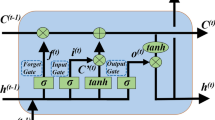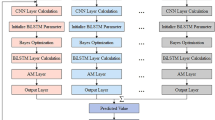Abstract
Obtaining reliable and high-accuracy prediction results of displacement trends in the long term is crucial for mitigating geohazards. Deep learning can capture dynamic and nonlinear characteristics in long-term time series and is widely used in landslide displacement prediction. However, its black-box attribute prevents decision-makers from understanding the basis of the model output, which limits the application of the model in the final optimization scenario. Thus, a novel “decomposition-prediction-addition-interpretative” framework including variational mode decomposition (VMD), double exponential smoothing (DES), and a long short-term memory network with spatiotemporal attention mechanism (TSAM-LSTM) is proposed. It enables high-precision multi-step prediction and spatiotemporal dimension interpretability analysis. Therein, VMD decomposes the total displacement into the trend, periodic, and random displacement, and the random displacement is further decomposed by VMD. On this basis, DES is used to predict the trend displacement, TSAM-LSTM to predict the periodic and random displacements, and finally, all the predicted values are superimposed to realize the total displacement prediction. The performance of the proposed approach was validated using monitoring data from H8 accumulation, Huangzangsi water conservancy project. The results indicate that the VMD-DES-TSAM-LSTM can achieve satisfactory prediction results. The introduction of TSAM improves the generalization ability of the traditional LSTM and significantly enhances its prediction performance. Meanwhile, TSAM accurately reveals the most relevant temporal and spatial information contained in input data that affects target displacement and visualizes the attention focus during model training, which provides a more favorable basis for model optimization and disaster prevention decision-making.

























Similar content being viewed by others
Data availability
Data will be available from the corresponding author on reasonable request.
References
Chen J, Zeng Z, Jiang P, Tang H (2015) Deformation prediction of landslide based on functional network. Neurocomputing 149:151–157
Chengqing Y, Guangxi Y, Chengming Y, Yu Z, Xiwei M (2023) A multi-factor driven spatiotemporal wind power prediction model based on ensemble deep graph attention reinforcement learning networks. Energy 263:126034
Dragomiretskiy K, Zosso D (2014) Variational mode decomposition. IEEE Trans Signal Process 62:531–544
Fukuzono T (1985) A new method for predicting the failure time of a slope. Proceedings of 4th International Conference and Field Workshop on Landslides. Tokyo University Press. pp 145–150
Guo Z, Chen L, Gui L, Du J, Yin K, Do HM (2020) Landslide displacement prediction based on variational mode decomposition and WA-GWO-BP model. Landslides 17:567–583
Hochreiter S, Schmidhuber J (1997) Long short-term memory. Neural Comput 9:1735–1780
Kong J, Zhuang J, Peng J, Ma P, Zhan J, Mu J, Wang J, Zhang D, Zheng J, Fu Y, Wang S, Du C (2023) Failure mechanism and movement process of three loess landslides due to freeze-thaw cycle in the Fangtai village, Yongjing County, Chinese Loess Plateau. Eng Geol 315:107030
Li SH, Zhu L, Wu Y, Lei XQ (2021) A novel grey multivariate model for forecasting landslide displacement. Eng Appl Artif Intell 103:104297
Li D, Nian T, Tiong RLK, Shen Y, Shao Z (2023) River blockage and impulse wave evolution of the Baige landslide in October 2018: insights from coupled DEM-CFD analyses. Eng Geol 321:107169
Liu Q, Lu G, Dong J (2021) Prediction of landslide displacement with step-like curve using variational mode decomposition and periodic neural network. Bull Eng Geol Environ 80:3783–3799
Long J, Li C, Liu Y, Feng P, Zuo Q (2022) A multi-feature fusion transfer learning method for displacement prediction of rainfall reservoir-induced landslide with step-like deformation characteristics. Eng Geol 297:106494
Ma J, Tang H, Hu X, Bobet A, Zhang M, Zhu T, Song Y, Ez Eldin MAM (2017) Identification of causal factors for the Majiagou landslide using modern data mining methods. Landslides 14:311–322
Mao W, Jiao L, Wang W (2022) Long time series ozone prediction in China: a novel dynamic spatiotemporal deep learning approach. Build Environ 218:109087
Pan H, Yuqi W, Xinyue M, Yifei C, Yu J, Yu Q, Xinyu H (2023) Landslide risk assessment of railway lines based on hierarchical grey relation analysis. Acad J Eng Technol Sci 9:73–82
Saito M (1965) Forecasting the time of occurrence of a slope failure. Proceedings of the 6th International Mechanics and Foundation Engineering. Pergamon Press, Oxford. pp 537–541
Shi G, Qin C, Tao J, Liu C (2021) A VMD-EWT-LSTM-based multi-step prediction approach for shield tunneling machine cutterhead torque. Knowl-Based Syst 228:107213
Wang H, Long G, Liao J, Xu Y, Lv Y (2022) A new hybrid method for establishing point forecasting, interval forecasting, and probabilistic forecasting of landslide displacement. Nat Hazards 111:1479–1505
Wang Y, Qin L, Wang Q, Chen Y, Yang Q, Xing L, Ba S (2023) A novel deep learning carbon price short-term prediction model with dual-stage attention mechanism. Appl Energy 347:121380
Wu L, Liu S, Yang Y (2016) Grey double exponential smoothing model and its application on pig price forecasting in China. Appl Soft Comput 39:117–123
Xu S, Niu R (2018) Displacement prediction of Baijiabao landslide based on empirical mode decomposition and long short-term memory neural network in Three Gorges area, China. Comput Geosci 111:87–96
Yang D, Qiu H, Hu S, Zhu Y, Cui Y, Du C, Liu Z, Pei Y, Cao M (2021) Spatiotemporal distribution and evolution characteristics of successive landslides on the Heifangtai tableland of the Chinese Loess Plateau. Geomorphology 378:107619
Yang C, Yin Y, Zhang J, Ding P, Liu J (2024) A graph deep learning method for landslide displacement prediction based on global navigation satellite system positioning. Geosci Front 15:101690
Zeng T, Glade T, Xie Y, Yin K, Peduto D (2023) Deep learning powered long-term warning systems for reservoir landslides. Int J Disaster Risk Reduction 94:103820
Zhang K, Zhang K, Cai C, Liu W, Xie J (2021) Displacement prediction of step-like landslides based on feature optimization and VMD-Bi-LSTM: a case study of the Bazimen and Baishuihe landslides in the Three Gorges, China. Bull Eng Geol Environ 80:8481–8502
Zhang X, Ye P, Wu Y, Zhai E (2022a) Experimental study on simultaneous heat-water-salt migration of bare soil subjected to evaporation
Zhang Y, Tang J, Cheng Y, Huang L, Guo F, Yin X, Li N (2022b) Prediction of landslide displacement with dynamic features using intelligent approaches. Int J Min Sci Technol 32:539–549
Zhang X, Du D, Man T, Ge Z, Huppert HE (2024a) Particle clogging mechanisms in hyporheic exchange with coupled lattice Boltzmann discrete element simulations
Zhang X, Du D, Wu Y, Ye P, Xu Y (2024b) Theoretical and analytical solution on vacuum preloading consolidation of landfill sludge treated by freeze–thaw and chemical preconditioning. Acta Geotech 19:221–238
Zhang X, Huang T, Wu Y (2024c) Soil drainage clogging mechanism under vacuum preloading: a review. Transp Geotech 45:101178
Zhao Y, Meng X, Yang H (2015) Jackknife empirical likelihood inference for the mean absolute deviation. Comput Stat Data Anal 91:92–101
Zhou C, Yin K, Cao Y, Ahmed B (2016) Application of time series analysis and PSO–SVM model in predicting the Bazimen landslide in the Three Gorges Reservoir, China. Eng Geol 204:108–120
Zosso D, Dragomiretskiy K (2013) Variational mode decomposition. IEEE Trans Signal Process 62:1–15
Acknowledgements
This work was supported by Guizhou Provincial Science and Technology Projects (No. QKHJC-ZK[2022]YB104). The authors thank the reviewers for their valuable suggestions.
Funding
This work was supported by Guizhou Provincial Science and Technology Projects (No. QKHJC-ZK[2022]YB104).
Author information
Authors and Affiliations
Contributions
Hong Wang and Peng Shao wrote the main manuscript. Hongfei Wang supervised the entire process. fei Gan provided financial assistance and data collection. chao Li built the data-driven model. yigang Cen and Xiangdong Xu processed the data and plotted the graphics. All authors reviewed the manuscript.
Corresponding author
Ethics declarations
Competing interest
The authors declared that they have no conflicts of interest in this work. We declare that we do not have any commercial or associative interest that represents a conflict of interest in connection with the work submitted.
Additional information
Publisher's Note
Springer Nature remains neutral with regard to jurisdictional claims in published maps and institutional affiliations.
Rights and permissions
Springer Nature or its licensor (e.g. a society or other partner) holds exclusive rights to this article under a publishing agreement with the author(s) or other rightsholder(s); author self-archiving of the accepted manuscript version of this article is solely governed by the terms of such publishing agreement and applicable law.
About this article
Cite this article
Wang, H., Shao, P., Wang, H. et al. A VMD-DES-TSAM-LSTM-based interpretability multi-step prediction approach for landslide displacement. Environ Earth Sci 83, 193 (2024). https://doi.org/10.1007/s12665-024-11503-7
Received:
Accepted:
Published:
DOI: https://doi.org/10.1007/s12665-024-11503-7




